10.0 MODULE OVERVIEW AND OBJECTIVES
Welcome to Module 10
This module includes the following four sections:
- 10.1 Introduction to water quality
- 10.2 A brief history of water quality and public health
- 10.3 Types of water pollutants
- 10.4 Water quality protection in the United States
This module also includes two case studies that you will become familiar with:
- 10.3.1 Bangladesh Case Study
- 10.4.1 Cuyahoga River Case Study
Module objectives:
By the end of this module you should be able to
- Describe the overall aim of the Millennium Development Goals. (Section 10.1)
- Recognize how the world is progressing on its water-related MDG and SDG targets. (Section 10.1)
- Explain why water-related illnesses were not common in early human history. (Section 10.2)
- Explain why water-related illnesses became more of a problem after the agricultural revolution. (Section 10.2)
- Describe general sanitary conditions and viewpoints on disease transmission prior to the mid 19th century. (Section 10.2)
- List factors that occurred in the late 19th century that led to a revolution in sanitation. (Section 10.2)
- Recognize while sanitation-related water contamination has been an issue for thousands of years, in the past 80 years industrial water pollution has become a growing concern. (Section 10.2)
- List examples of point source pollution. (Section 10.3)
- List examples of non-point source pollution. (Section 10.3)
- Explain why non-point source pollution is more difficult to control than point source. (Section 10.3)
- Explain how suspended solids and sediments can negatively impact aquatic plants. (Section 10.3)
- List the most common plant nutrients (Section 10.3)
- List the most common sources of nutrient pollution. (Section 10.3)
- Describe the process of eutrophication and list the anthropogenic contributors to eutrophication. (Section 10.3)
- List the most common pathways by which microorganisms enter water bodies. (Section 10.3)
- List several common chemical pollutants. (Section 10.3)
- List the types of pollutants that are commonly found in municipal waste. (Section 10.3)
- List the types of pollutants that are commonly found in agricultural waste. (Section 10.3)
- List several commonly used items that contain endocrine disruptors. (Section 10.3)
- Recognize that typical water treatment plants are not effective at removing emerging contaminants. (Section 10.3)
- Briefly describe the current state of knowledge about the impacts of emerging contaminants on human health and the environment. (Section 10.3)
- Recognize there are not EPA standards for most emerging contaminants. (Section 10.3)
- Discuss arsenic in Bangladesh as an example of a naturally occurring contaminant. (Section 10.3)
- Discuss the importance of testing private wells for a wide variety of contaminants. (Section 10.3)
- Recognize that even relatively low concentrations of elements in rocks can result in harmful concentrations of the element in groundwater in certain geological settings (Section 10.3)
- State the broad goal of the Clean Water Act (Section 10.4)
- State what NPDES stands for (Section 10.4)
- Discuss the history of pollution on the Cuyahoga River and how it helped spur the creation of the Clean Water Act (Section 10.4)
- List regulatory and non-regulatory tools employed by the Clean Water Act (Section 10.4)
- Know the following definitions…
- Improved sanitation
- Water pollution
- Point source pollution
- Non-point source pollution
- Suspended solids
- Biochemical oxygen demand (B.O.D.)
- Emerging contaminants
- Endocrine disruptors
- Designated use
- Impaired waters
- TMDL
Module Assignments
Module 10 quiz: Check the course schedule in Canvas to see when you need to take the quiz.
10.1 INTRODUCTION TO WATER QUALITY
Let’s start this module with some statistics about water quality…
- 900 million people have access to rudimentary sanitation and therefore must practice open defecation (1)
- In 2015 roughly 30% of the global population was not using a safely managed drinking water supply (a supply that is located on premises, is free from contamination, and is available when needed) (1)
- In 2015 263 million people spent over 30 minutes per round trip to collect water from an improved source (1)
- In 2015 159 million people collected drinking water directly from surface water sources. 58% of these 159 million people lived in sub-Saharan Africa. (1)
Globally, 80% of wastewater flows back into the ecosystem without being treated or reused. (2)
Since the 1990s, water pollution has worsened in almsot all rivers in Africa, Asia, and Latin America (5)
By 2050, close to 80% of the world’s population will live in cities, compared to 50% today. Most cities do not currently have the infrastructure and resources to address wastewater management efficiently and sustainably. (3)
1.8 billion people are using a drinking water source that is contaminated with feces, which puts them at risk for contracting cholera, dysentery, typhoid, and polio. (4)
At least 140 million people living in 50 countries have been drinking water containing arsenic at concentrations above the World Health Organization’s guideline. (5)
- An estimated 500,000 abandoned mines in the U.S. will cost between $20 billion and $54 million in management and remediation of pollution. (6)
References for above statistics
(1) UNICEF, 2017. Progress on drinking water, sanitation, and hygiene.
(2) UN, 2017. World Water Development Report.
(3) UN, 2014. World Urbanization Prospects.
(4) WHO/UNICEF, 2015. Progress on sanitation and drinking water – 2015 update and MDG assessment.
(5) WHO, Arsenic.
(6) CBS15, Sacramento, 2015. EPA: National cost of leaking-mine cleanup could surpass $50 billion
Now let’s cover some definitions…
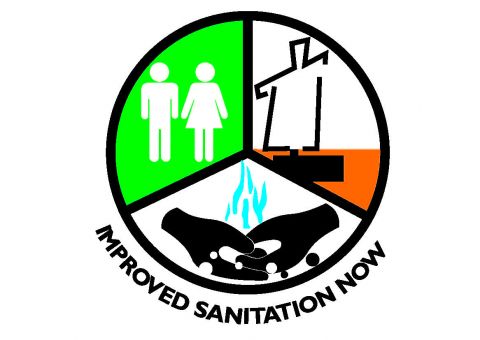
As indicated by some of the statistics above, lack of access to improved sanitation is one of the major causes of water-related illnesses. So, what is improved sanitation? The United Nations defines improved sanitation as follows:
- Facilities that ensure hygienic separation of human excreta from human contact including (e.g. toilets or latrines, and septic tanks or sewer systems)
Water pollution occurs when substances are present in water bodies at a high enough concentration to cause harm to human health, animals, plants, or the wider environment. Note that for the purposes of this class, the pollutants can be introduced to the water either through human activities or naturally.
Point source pollution: pollution that comes from a discrete identifiable source such as a pipe or leaky underground storage tank. The photo below shows an example of point source pollution entering the Calumet River near Chicago.
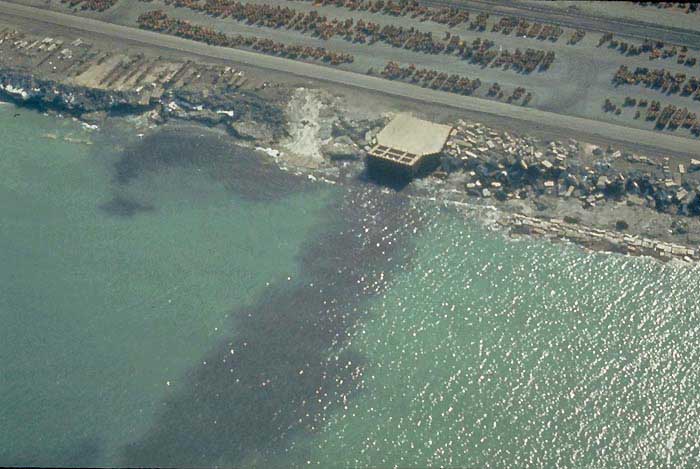
Non-point source pollution: pollution that originates over a large area making it difficult to locate the source of the pollution. Examples of non-point source pollution include fertilizer or pesticides in runoff from suburban lawns or agricultural fields. Because it comes from a wide area rather than a discrete source, non-point source pollution can be particularly difficult to control.
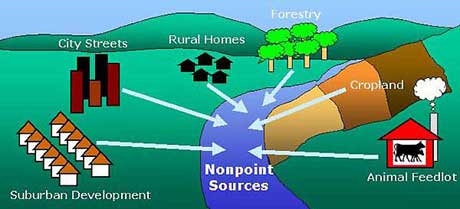
Suspended solids (also called suspended sediment and suspended particulate matter): particles suspended in the water, as opposed to particles that have settled to the bottom of the water column, which are then called sediments. The satellite image below shows suspended solids entering Long Island Sound from the Connecticut River after Hurricane Irene in 2011.
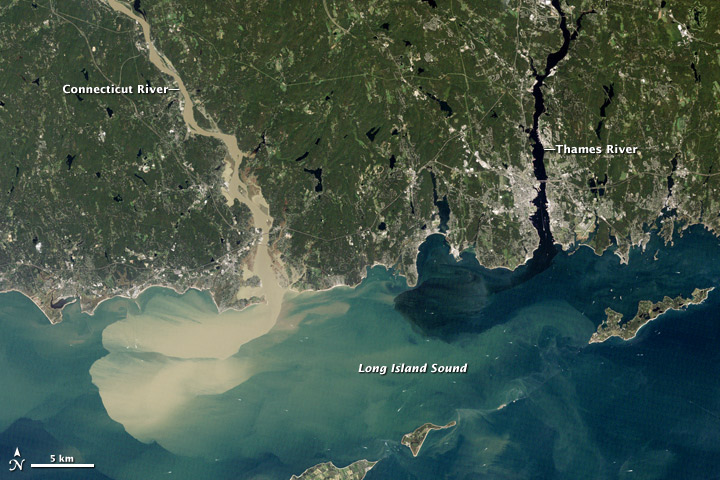
Eutrophication: the process of a water body becoming enriched by nutrients. Although eutrophication can happen naturally, it is greatly accelerated by runoff containing fertilizers, sewage, or animal waste. The abundance of nutrients in the water causes algae to bloom (see satellite image below showing algal bloom in Lake Okeechobee). When the algae die, they decompose. That decomposition process consumes oxygen. Additionally, the algae block sunlight from reaching other aquatic plants. Without sunlight, photosynthesis does not proceed and the plants do not release oxygen. So, eutrophication leads to oxygen depletion.

Biochemical oxygen demand (B.O.D.) is a measure of the amount of oxygen required by microorganisms to decompose the organic matter in water. The more organic matter there is in the water, the more oxygen is required to decompose it. So, high biochemical oxygen demand is an indication of high levels of organic matter in the water.
An integral part of developing standards for water quality are determining the designated use(s),e.g. drinking, swimming, the protection and propagation of aquatic life. Designated use(s) represent goals for the use of the water body and therefore may extend well beyond the current use. Impaired waters are water bodies that do meet water quality criteria and are therefore not suitable for their designated use.
Total maximum daily load (TMDL) is the maximum amount of a pollutant that can enter a water body such that the water body will meet the water quality criteria for that pollutant.
Global Perspective on Water Quality and Sustainability…
In 2000, the United Nations implemented the Millennium Development Goals program (MDG). This program, the most broadly supported international effort to reduce poverty, had established a set of targets for reducing poverty and improving human health by 2015.
- One of the MDG targets was to reduce the number of people without access to safe drinking water by 1/2 by the year 2015, and this target was met in 2010, five years ahead of schedule.
- Another target was to reduce the percent of the global population without access to adequate sanitation to 25% by 2015. As the graphs below show, this target was not met.
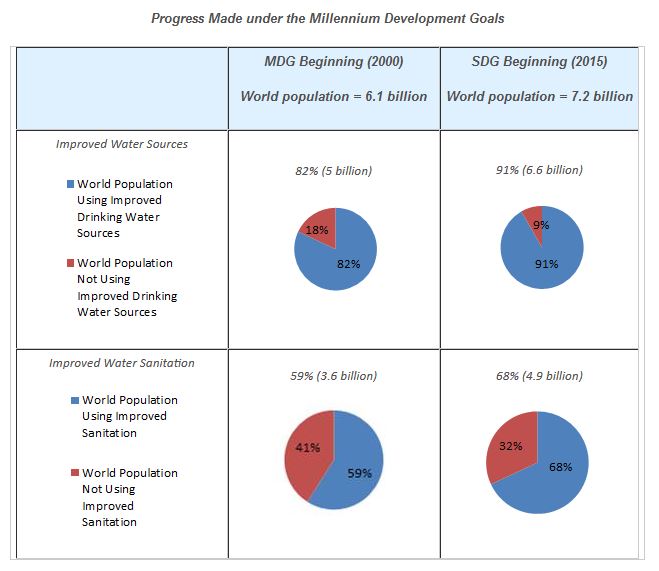
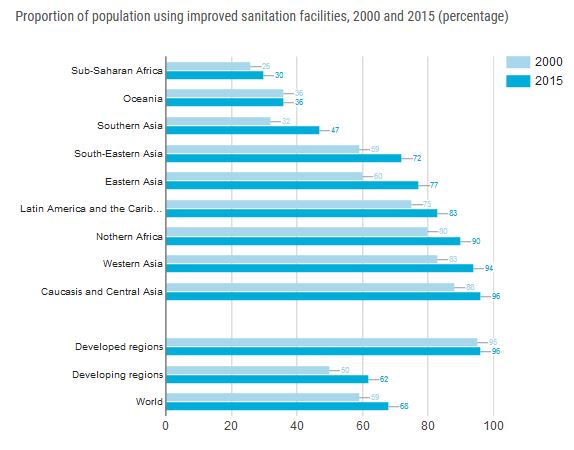
Post-2015 the United Nations expanded on the MDG with its Sustainable Development Goals to end poverty, protect the planet, and ensure prosperity for all.
- Goal 6 of the Sustainable Development Goals is to “ensure availability and sustainable management of water and sanitation for all”
Read the following article for more details about Sustainable Development Goal 6 and our progress on reaching the goal.
Billions around the world lack safe water, proper sanitation facilities, reveals UN report
From: http://www.un.org/sustainabledevelopment/blog/2017/07/billions-around-the-world-lack-safe-water-proper-sanitation-facilities-reveals-un-report/, last accessed 7/23/17.
Some three in ten people around the world lack access to safe and readily available water at home, and almost six in ten to safely managed sanitation, a new United Nations report has warned, calling on countries to do more to fulfil these basic human needs.
According to the World Health Organization (WHO) and the UN Children’s Fund (UNICEF) joint report, Progress on Drinking Water, Sanitation and Hygiene: 2017 Update and Sustainable Development Goal Baselines, many homes, healthcare facilities and schools also lack soap and water for handwashing, putting the health of all people – but especially young children – at risk for deadly diseases.
“Safe water, sanitation and hygiene at home should not be a privilege of only those who are rich or live in urban centres,” Tedros Adhanom Ghebreyesus, the WHO Director-General, said in a news release, announcing the findings and noting that those living in rural areas are the worst affected.
As a result of lack of these basic services, millions fall ill to diseases – that could, otherwise, have been easily prevented – such as diarrhoea which claims the lives of 361,000 children under the age of five die, every year, noted the UN agencies.
“Safe water, effective sanitation and hygiene are critical to the health of every child and every community – and thus are essential to building stronger, healthier, and more equitable societies,” underscored Anthony Lake, the Executive Director of UNICEF.
Good hygiene is one of the simplest and most effective ways to prevent the spread of diseases such as diarrhoea, cholera, dysentery, hepatitis A, and typhoid.
However, findings in the report revealed that access to water and soap for handwashing varies immensely in the 70 countries with available data, from 15 per cent of the population in sub-Saharan Africa to 76 per cent in western Asia and northern Africa.
These significant inequalities also put the implementation of the Sustainable Development Goals (SDGs), in particular Goal 6 on ensuring availability and sustainable management of water and sanitation for all at risk.
Backed by the data, the two UN agencies also warned that in as many as 90 countries around the world, progress towards basic sanitation is too slow, “meaning they will not reach universal coverage by 2030”.
In addition, hundreds of millions without even ‘basic’ drinking water
According to the report, of the 2.1 billion people who do not have safely managed water, 844 million do not have even a basic drinking water service.
This includes 263 million people who have to spend over 30 minutes per trip collecting water from sources outside the home, and 159 million who still drink untreated water from surface water sources, such as streams or lakes.
Furthermore, of the 4.5 billion people who do not have safely managed sanitation, 2.3 billion still do not have basic sanitation services, including nearly 600 million people who share a toilet or latrine with other households, and 892 million people – mostly in rural areas – who defecate in the open.
Improvements these services, are therefore essential not only for realizing the 2030 Agenda for Sustainable Development and giving the most vulnerable a chance at a better future.
“As we improve these services in the most disadvantaged communities and for the most disadvantaged children today, we give them a fairer chance at a better tomorrow,” said Mr. Lake.
In the same vein, Mr. Ghebreyesus underscored: “These are some of the most basic requirements for human health, and all countries have a responsibility to ensure that everyone can access them.”
10.2 A BRIEF HISTORY OF WATER QUALITY AND PUBLIC HEALTH
Most of the information in this section comes from an article titled A Brief History of Water and Health from Ancient Civilizations to Modern Times. I have outlined the key points in the following paragraphs. But if you are interested, I encourage you to read through the full article, which you can access by clicking on the button below.
Information relating to water quality and public health is only available for relatively recent history. However, it is likely that water-related illnesses were uncommon for most of human history. Humans’ natural aversion to water with a bad odor, taste and/or color helped protect us from water-borne diseases, especially when human populations were very small and water resources were not stressed. Additionally, until the agricultural revolution approximately 10,000 years ago, humans practiced a hunter-gatherer lifestyle. Due both to the small populations and the nomadic lifestyle, human sanitary practices (e.g. washing, urination, and defecation) probably had a negligible impact on water quality.
With the agricultural revolution, humans began to settle, build cities, and practice intensive farming and ranching. With large numbers of people relying on the same water source in perpetuity and land uses that generate contamination, water quality problems became more of an issue.
The earliest writings linking water quality to human ailments date back to approximately 500 b.c. The ancient Greeks and Romans used settling tanks, filtration, and boiling to clean water.
As we saw in Module 2.3 early this semester, after the fall of the Roman Empire western civilization entered the Dark Ages, a long period where scientific and technological knowledge was stagnant. During the Dark Ages, sanitary conditions in the western world were deplorable, and water-related illnesses were rampant.
Following the Dark Ages, the western world entered the Age of Enlightenment, a period that saw rapid urbanization and industrialization. The world’s growing cities were overwhelmed by environmental and public health problems in the 18th and 19th centuries. However, several things began to happen in the 19th century that would forever change sanitation and water supply.
- There was a growing understanding of the mechanisms of disease transmission. Whereas people had previously thought that diseases were transmitted by miasmas (basically bad smells), advances in medicine, epidemiology, and microscopy revealed that microorganisms cause diseases and that disease causing microorganisms are often present in sewage-contaminated water supplies.
- An 1854 study by a London physician named John Snow, which linked a cholera outbreak to a particular well, is often attributed with starting a revolution in sanitation. While his study was a remarkable advancement in epidemiological analysis, his findings actually had relatively little influence on the people who made decisions about London’s sanitation. However, his story still serves as an excellent example of London’s sanitary conditions in this 1800’s and of the general mindset towards sanitation at that time. Watch the following YouTube video about John Snow.
- Advances in analytical chemistry and microscopy made it possible for us to detect compounds and microorganisms in water. Thus our understanding of what is in our water supplies began to drastically improve.
- Technological advances made wide-scale treatment of municipal water supplies possible. Filtering of water supplies for entire towns began in the second half of the 19th century and chlorination of municipal water supplies began in the early 20th century.
With the advent of large-scale water treatment processes, sanitation-related water contamination has been a rare occurrence in the developed world since the early 1900’s. However, as you saw in the previous section, sanitation related illness are still all too common in developing countries. Since the 1960’s issues with industrial contamination of water bodies have been a growing concern worldwide.
10.3 WATER POLLUTION
Overview of water pollution types
Now that you have a bit of a historical perspective about water quality and human health, this section will summarize the basic types of water pollution. Note that my objective here is not to cover chemistry in any detail but rather to provide an overview of the variety of contaminants of concern and also to cover some of the fundamental water quality vocabulary.

Click on the following button to access an online module about hygiene and environmental health. Scroll down through the table of contents in the left hand navigation pane to access Module 17.1 -17.3 as shown in the screenshot here.
Pay particular attention to…
1. The definition and examples of point source and non-point source pollution
2. The major types of water pollutants
- Sediments and suspended solids
- Nutrients
- Biological pollutants
- Chemical pollutants
3. The harmful effects of suspended solids and sediment
4. The nutrients that are most commonly required for plant growth and that often lead to eutrophication.
5. The most common pathways for microorganisms to enter water bodies.
6. The types of pollutants that are commonly found in municipal wastewater
7. The types of pollutants that are commonly found in agricultural waste.
8. The most common chemical pollutants.
9. The process of eutrophication.
Note the website treats deoxygenation and eutrophication as if they are separate processes. However, typically eutrophication is used to describe what the website refers to as deoxygenation as well a eutrophication. The site covers eutrophication only briefly. Check out the following video and diagram for more detail about eutrophication.
Embedded from: https://www.youtube.com/watch?v=wMZ8xfHPNu8, last accessed 7/23/17.
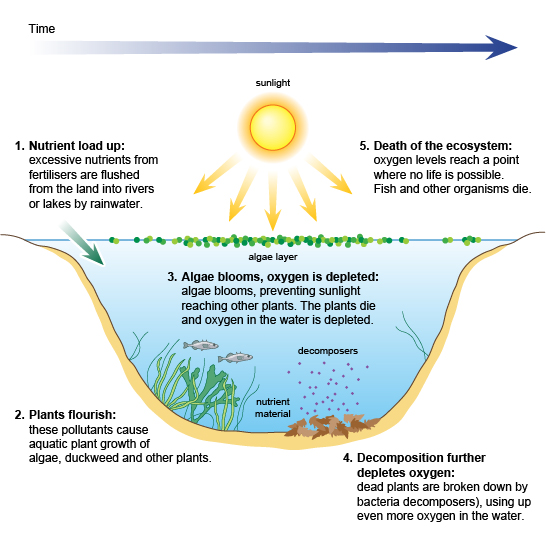
Note that metals contamination, while often a byproduct of industrial activities, can be from naturally occurring sources. Metals occur naturally in many crustal rocks. As long as these metals are bound to or within the rock, they do not pose a threat to drinking water supplies. However, these metals can become mobile (dissolved out of the rock into the water) in certain circumstances. There are several examples of unsafe levels of metals from natural sources in drinking water. The arsenic case study in the next section is the most dramatic example of a naturally occurring contamination in water; however there are numerous similar problems, although smaller scale, problems worldwide. In fact, my Ph.D. research focused on naturally occurring arsenic in groundwater in Wisconsin.
As humans develop and use a larger variety of chemical compounds, there are new categories of pollution appearing in water. Things like, caffeine, birth control medicines, antibiotics, blood pressure medicine, compounds that are ubiquitous in hand soap, etc. are commonly found in water. We call these types of pollutants emerging contaminants. Part of why we are now detecting more and more emerging contaminants is that our analytical capabilities have only recently evolved to be able to detect low levels of these compounds. However, even though our analytical capabilities are constantly improving, some emerging contaminants likely have adverse health effects at concentrations lower than we are able to detect. There are several unique problems associated with emerging contaminants.
- Our drinking water treatment systems were not designed to remove these compounds, and it has been shown that traditional municipal water treatment technologies are not effective at removing these compounds.
- We have very little data about how these compounds influence human health at small concentrations ingested frequently over long time periods.
- While relatively little is known about how each of these individual compounds influence human health and the environment, even less is known about how these various compounds interact with each other in water and their combined effects on human health and the environment.
To learn more about these emerging contaminants, watch the video on the embedded webpage below.
You should be able to
- Define endocrine disruptors
- List several commonly used items that contain endocrine disruptors
- Explain that many emerging contaminants have health effects at concentrations lower than what our analytical capabilities can detect
- Recognize that the EPA has not set standards for most of these emerging contaminants.
10.3.1 BANGLADESH CASE STUDY
As noted in the previous section, water contamination can occur from natural sources. It is not uncommon for metals that occur naturally in Earth’s crustal rocks to be present in water at high enough concentrations to cause serious human health problems. Arsenic contamination from natural sources has received a lot of attention in recent decades. As you will learn from the following podcast, arsenic from natural sources sickened hundreds of thousands of people in Bangladesh in the 1990’s, but there have been significant public health problems associated with naturally occurring arsenic in many other places, including Vietnam and the Midwestern United States.
Also, although arsenic probably receives the most attention, there are known instances of water contamination from other naturally occurring elements, including fluorine and manganese. Contamination from naturally occurring sources is rarely a problem in municipal water supplies because water utilities routinely test for, and if necessary, treat for these compounds. However, billions of people worldwide are not served by municipal water utilities. Even in the United States a very large portion of the population lives in rural areas that rely on water from private wells because they are not served by a municipal utility.
There are no federal or state requirements for routine water quality testing of water from private wells that supply water to only a few people. Well drillers and people who service private wells generally recommend annual testing for fecal coliform and possibly nitrates, but even these tests are not required. So, one of the biggest challenges to preventing public health risks due to naturally occurring contaminants is to educate people about the importance of routine testing of their well water for a wider variety of compounds.
Listen to the following podcast
This case study serves as an excellent example of several things relevant to this unit and other topics covered in this class.
- Pathogenic organisms in water
- Naturally occurring contaminants in water
- Problems that occur when groundwater from private wells is not tested for a wider variety of contaminants
- Notice how the researchers examined the spatial distribution of illnesses to determine that problem was not caused by a point source
- Take note of how agricultural production in Bangladesh was increased when a more abundant water source became available. This ties back to our earlier module on water and agriculture.
- Note that arsenic concentrations in rock which are average or even below average can lead to dangerously high arsenic concentrations in ground water. This is due to the complexity of the chemical interactions between groundwater and its host rocks. You don’t need to understand the geochemistry covered in the story in any detail for this class. But notice the complex set of circumstances, which began long ago in earth’s history and involved processes at scales ranging from continental tectonics to microorganisms, that led to the arsenic problem in Bangladesh. We have learned that in order to understand naturally occurring contamination, we need to study these complex reactions in more detail than was typically done previously.
The above audio story does a really nice job of explaining in relatively clear terms the interactions between geology, chemistry, microbiology, and humans that led to the arsenic contamination in Bangladesh; however, there are some inaccuracies in the story that I want to correct.
- The report fails to make the correct distinction between minerals and rocks. Instead of saying that the arsenic occurred in sulfide rocks, they should have said that the arsenic occurred in sulfide minerals, and those sulfide minerals are components in the rocks.
- The report states that the geologic setting with regards to the occurrence and partitioning of arsenic is rather unique. I disagree with this. Although there are plenty of geologic settings where arsenic does preferentially stay bound to the solids, we have realized that there are numerous locations around the world where geochemical conditions favor arsenic dissolving out of the rock and entering the groundwater.
- The story suggests that under anaerobic conditions, microorganisms start breathing the oxygen in iron-oxide minerals. This is not a correct representation of the process. You don’t need to understand the process for this class, but in case you are interested, here is an explanation of what really happens… microorganisms are “eating” by decomposing organic matter. The decomposition process is an oxidation-reduction reaction (remember oxidation-reduction reactions involve the transfer of elections). When O2 is present, it is the most favorable electron acceptor for the decomposition of organic matter. When oxygen is not present, microoganisms switch to less favorable electron acceptors, one of which is iron Thus, rather than microbes “breathing oxygen in rust minerals”, it is the microbes using iron as an electron acceptor for the decomposition of organic matter that causes the iron minerals to dissolve into water.
10.4 WATER QUALITY PROTECTION
The Clean Water Act
The Clean Water Act (CWA) is the primary regulatory tool for protecting the quality of surface water in the United States. Familiarize yourself with objectives and history of the CWA by watching the following YouTube video and going through sections 1 – 4 of the E.P.A.’s Introduction to the Clean Water Act, which is below the video.
Embedded from: https://www.youtube.com/watch?v=ZEQcUngxbLI, last accessed 7/23/17.
Pay particular attention to…
- The broad goal of the CWA
- The list of regulatory and non-regulatory tools employed by the CWA
- Whether the CWA currently addresses point source or point source pollution or both
- What NPDES stands for
- The history of pollution on the Cuyahoga River and how it helped spur the creation of the CWA (Note the the next module is a case study of the Cuyahoga River and you will get a much broader picture of the history of Cuyahoga River through that case study.)
- How the CWA uses a combination of enforceable water quality standards, treatment technologies, and permits for discharges to protect surface water quality.
The specifics of the CWA are beyond the scope of this class; however, I would like you all to be familiar with the impaired waters and TMDL regulations. The CWA requires states to list water bodies that do not meet water quality criteria and are therefore unsuitable for their designated use as impaired waters (see the table below).

Designated use refers to the goals for use of the water body (e.g. swimming, boating, irrigation, etc.). For each impaired water, states are required to develop Total Maximum Daily Loads (TMDLs). TMDLs are the maximum amount (load) of a pollutant that can enter the waterbody so that the waterbody will meet the water quality standard for that particular pollutant. States then allocate permits for discharge so that the TMDLs are not exceeded.
Note the CWA targets pollution and aims to clean up the nation’s water bodies in-situ. It does not regulate drinking water. The Safe Drinking Water Act sets water quality standards for drinking water and regulates water utilities. More details about the Safe Drinking Water Act will be covered in the next module.
10.4.2 CUYAHOGA RIVER CASE STUDY
As we learned in the previous section, the Cuyahoga River fire of 1969, was a motivating force in creating laws for environmental protection, including the CWA. However, just like the lore surrounding John Snow’s epidemiological findings about the London cholera outbreak have been exaggerated by history (section 11.2), so too has the 1969 Cuyahoga River fire. But also, like the tale of John Snow’s discovery about cholera, the story of the Cuyahoga River provides tremendous insight into the general quality of the nation’s waters prior to the CWA and the general attitude towards water pollution at the time. To get more in depth information about the Cuyahoga River, read through this following embedded webapge and watch the two short videos that are at the bottom of the webpage.
You should be able to summarize the history of pollution in the Cuyahoga River and recognize that the river had burned several times prior to 1969 but the mood of the country and politics combined with press coverage of the 1969 fire made the 1969 incident infamous.
END OF MODULE 10
